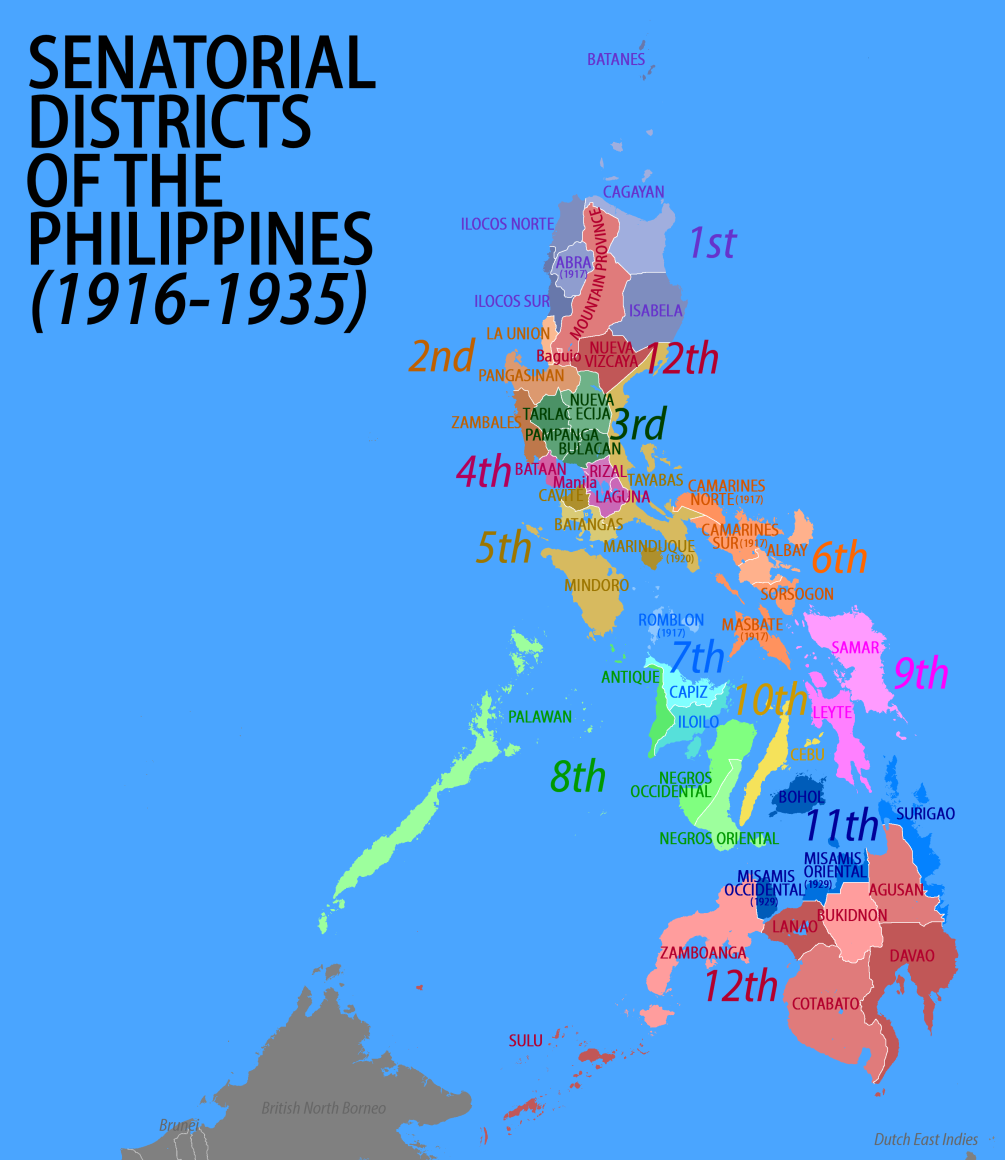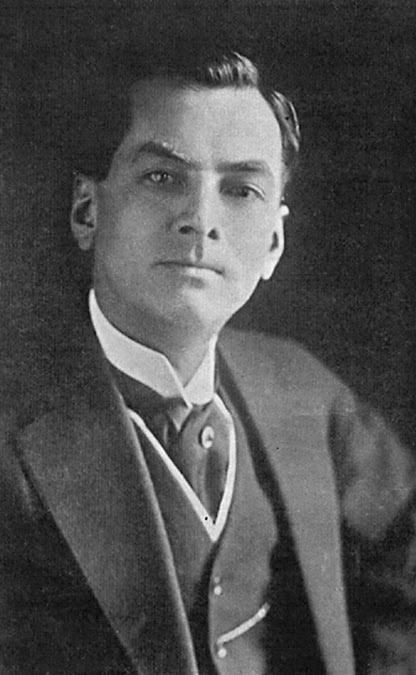|
Philippines's 7th Senatorial District
Philippines's 7th senatorial district, officially the Seventh Senatorial District of the Philippine Islands ( es, Séptimo Distrito Senatorial de las Islas Filipinas), was one of the twelve senatorial districts of the Philippines in existence between 1916 and 1935. It elected two members to the Senate of the Philippines, the upper chamber of the bicameral Philippine Legislature under the Insular Government of the Philippine Islands for each of the 4th to 10th legislatures. The district was created under the 1916 Jones Law from the western Visayas provinces of Capiz and Iloilo. Romblon was added in 1917 upon its re-establishment as a regular province separate from Capiz. The district was represented by a total of eight senators throughout its existence. It was abolished in 1935 when a unicameral National Assembly was installed under a new constitution following the passage of the Tydings–McDuffie Act which established the Commonwealth of the Philippines. Since the 1941 elections ... [...More Info...] [...Related Items...] OR: [Wikipedia] [Google] [Baidu] |
Senatorial Districts Of The Philippines
The senatorial districts of the Philippines were the representations of the provinces of the Philippines in the Philippine Senate from 1916 to 1935. History The enactment of the Philippine Autonomy Act (popularly known as "Jones Law") in August 1916 by the United States Congress provided for the creation of a bicameral legislature consisting of a lower chamber (House of Representatives) and an upper chamber (Senate). Until then the Philippine Commission held the executive power and some legislative powers over the American colony. The system of government of the Philippines in its early years of transition to democratic self-government was deliberately structured to emulate the American model. The Philippines thus followed the American system of electing the members of the 24-seat senate by district. The districts were organized and numbered in a roughly north–south fashion, much like the present administrative regions. The first eleven districts were composed of establish ... [...More Info...] [...Related Items...] OR: [Wikipedia] [Google] [Baidu] |
Nacionalista Party
The Nacionalista Party (Filipino and Spanish: ''Partido Nacionalista''; ) is the oldest political party in both the Philippines and in Southeast Asia in general. It is responsible for leading the country throughout the majority of the 20th century since its founding in 1907; it was the ruling party from 1935 to 1946 (under Presidents Manuel L. Quezon and Sergio Osmeña), 1953–1961 (under Presidents Ramon Magsaysay and Carlos P. Garcia) and 1965–1972 (under President Ferdinand Marcos). Ideology The Nacionalista Party was initially created as a Filipino nationalist party that supported Philippine independence until 1946 when the United States granted independence to the country.Liow, J.; Leifer, M. (1995)''Dictionary of the Modern Politics of Southeast Asia'' New York: Routledge. Retrieved October 16, 2017. Since then, many scholarly articles that dealt with the history of political parties during the Third Republic agreed that the party has been increasingly populist,Celo ... [...More Info...] [...Related Items...] OR: [Wikipedia] [Google] [Baidu] |
1928 Philippine Senate Elections
Legislative elections happened on June 5, 1928, in the Philippines under the Jones Law provisions. Electoral system In a staggered election, the seats of the senators who were first disputed in 1922 were up for election. The Philippines is divided into 12 senatorial districts, of which all districts save for the 12th district, has one of its seats up. In the 12th district, any vacancy is filled via appointment of the Governor-General. The election itself is via first-past-the-post. Results See also *8th Philippine Legislature *Commission on Elections *Politics of the Philippines *Philippine elections External linksOfficial website of the Commission on Elections {{Philippine elections 1928 Events January * January – British bacteriologist Frederick Griffith reports the results of Griffith's experiment, indirectly proving the existence of DNA. * January 1 – Eastern Bloc emigration and defection: Boris Bazhan ... 1928 elections in the Phili ... [...More Info...] [...Related Items...] OR: [Wikipedia] [Google] [Baidu] |
1925 Philippine Senate Elections
Senatorial elections happened on June 2, 1925 in the Philippines under the Jones Law provisions. Electoral system In a staggered election, the seats of the senators who were first disputed in 1919 were up for election. The Philippines is divided into 12 senatorial districts, of which all districts save for the 12th district, has one of its seats up. In the 12th district, any vacancy is filled via appointment of the Governor-General. The election itself is via first-past-the-post. Results See also *7th Philippine Legislature *Commission on Elections *Politics of the Philippines *Philippine elections External linksOfficial website of the Commission on Elections {{Philippine elections 1925 Events January * January 1 ** The Syrian Federation is officially dissolved, the State of Aleppo and the State of Damascus having been replaced by the State of Syria. * January 3 – Benito Mussolini makes a pivotal speech in the Italia ... 1925 elections in the Philippin ... [...More Info...] [...Related Items...] OR: [Wikipedia] [Google] [Baidu] |
7th Philippine Legislature
The Seventh Philippine Legislature was the meeting of the legislature of the Philippines under the sovereign control of the United States from 1925 to 1928. Members Senate Notes House of Representatives Notes See also *Congress of the Philippines *Senate of the Philippines *House of Representatives of the Philippines The House of Representatives of the Philippines ( fil, Kapulungan ng mga Kinatawan ng Pilipinas, italic=unset, ''Kamara'' or ''Kamara de Representantes'' from the Spanish language, Spanish word ''cámara'', meaning "chamber") is the lower house ... External links * * Further reading *Philippine House of Representatives Congressional Library * * {{Philippine legislative periods 07 ... [...More Info...] [...Related Items...] OR: [Wikipedia] [Google] [Baidu] |
6th Philippine Legislature
The Sixth Philippine Legislature was the meeting of the legislature of the Philippines under the sovereign control of the United States from 1922 to 1925. Members Senate Notes House of Representatives Notes See also *Congress of the Philippines *Senate of the Philippines *House of Representatives of the Philippines The House of Representatives of the Philippines ( fil, Kapulungan ng mga Kinatawan ng Pilipinas, italic=unset, ''Kamara'' or ''Kamara de Representantes'' from the Spanish language, Spanish word ''cámara'', meaning "chamber") is the lower house ... External links * * Further reading *Philippine House of Representatives Congressional Library * * {{Philippine legislative periods 06 ... [...More Info...] [...Related Items...] OR: [Wikipedia] [Google] [Baidu] |
1922 Philippine Senate Elections
Senatorial elections were held on June 6, 1922 in the Philippines under the Jones Law provisions. It was controversial when Senate President Manuel L. Quezon accused Sergio Osmeña of using public funds in campaigning which resulted to the Nacionalista Party to be split. Electoral system In a staggered election, the seats of the senators who were first place in 1916 were up for election. The Philippines is divided into 12 senatorial districts, of which all districts save for the 12th district, has one of its seats up. In the 12th district, any vacancy is filled via appointment of the Governor-General. The election itself is via first-past-the-post. Results See also * 6th Philippine Legislature *Commission on Elections *Politics of the Philippines *Philippine elections External linksOfficial website of the Commission on Elections {{Philippine elections 1922 Events January * January 7 – Dáil Éireann (Irish Republic), Dáil Éireann, the parliament of the I ... [...More Info...] [...Related Items...] OR: [Wikipedia] [Google] [Baidu] |
Demócrata Party
The Democrata Party, also known as ''Partido Democrata Nacional'' () was a political party in early 20th century Philippines, when the Philippines was an insular territory of the United States. It functioned as an opposition party against the ruling Nacionalista Party. History The Democrata Party came from the remnants of the Progresista Party, which had been defeated by the Nacionalistas. Juan Sumulong founded the Democrata party in 1917, espousing "''absolute and immediate independence''". In the 1922 election, the Nacionalistas were split into two camps: Senate President Manuel L. Quezon pushed for collective leadership, calling Speaker Sergio Osmeña's leadership style as "''unipersonal''", a charge Osmeña denied. Thus, Quezon and his allies were the "Colectivistas", while Osmeña and his allies were the "Unipersonalistas". Osmeña decided to run for the Senate, directly challenging Quezon's authority. This led to the Nacionalistas losing their majority in the House of Re ... [...More Info...] [...Related Items...] OR: [Wikipedia] [Google] [Baidu] |
1919 Philippine Senate Elections
Senatorial elections happened on June 3, 1919 in the Philippines under the Jones Law provisions. There were 717,295 registered voters, of whom 672,122, or 92 percent, voted. Electoral system In a staggered election, the seats of the senators who were second place in 1916 were up for election. The Philippines is divided into 12 senatorial districts, of which all districts save for the 12th district, has one of its seats up. In the 12th district, any vacancy is filled via appointment of the Governor-General. The election itself is via first-past-the-post. Results See also *5th Philippine Legislature *Commission on Elections *Politics of the Philippines *Philippine elections External linksOfficial website of the Commission on Elections {{Philippine elections 1919 Events January * January 1 ** The Czechoslovak Legions occupy much of the self-proclaimed "free city" of Pressburg (now Bratislava), enforcing its incorporation into the new republic of Czechoslovakia. ... [...More Info...] [...Related Items...] OR: [Wikipedia] [Google] [Baidu] |
José María Arroyo
José María Arroyo y Pidal (1875 – March 8, 1927) was a Filipino politician. He served as the representative of the first district of Iloilo from 1916 to 1919, and as a senator representing the seventh senatorial district from 1919 until his death in 1927. Arroyo died in Italy on March 8, 1927. He is the grandfather of former first gentleman, Jose Miguel Arroyo who is the husband of former president Gloria Macapagal Arroyo. The Arroyo Fountain in front of the Iloilo Provincial Capitol and built in 1927 was named after him in recognition for his efforts of authoring Republic Act No. 3222, a law that establishes the Iloilo Metropolitan Waterworks in 1925. It stands on Kilometer Zero as the benchmark to measure distances from Iloilo City to other points in Panay Island, Western Visayas Western Visayas ( hil, Kabisay-an Nakatundan; tl, Kanlurang Kabisayaan or ''Kanlurang Visayas'') is an administrative region in the Philippines, numerically designated as Region VI. It consi ... [...More Info...] [...Related Items...] OR: [Wikipedia] [Google] [Baidu] |
5th Philippine Legislature
The Fifth Philippine Legislature was the meeting of the legislature of the Philippines under the sovereign control of the United States from 1919 to 1922. Members Senate Notes House of Representatives Notes See also *Congress of the Philippines *Senate of the Philippines *House of Representatives of the Philippines The House of Representatives of the Philippines ( fil, Kapulungan ng mga Kinatawan ng Pilipinas, italic=unset, ''Kamara'' or ''Kamara de Representantes'' from the Spanish language, Spanish word ''cámara'', meaning "chamber") is the lower house ... External links * * Further reading *Philippine House of Representatives Congressional Library * * {{Philippine legislative periods 05 ... [...More Info...] [...Related Items...] OR: [Wikipedia] [Google] [Baidu] |
Francisco Felipe Villanueva
Francisco Felipe Villanueva (October 10, 1867 – August 25, 1923) was a Filipino political leader during the Philippine–American War. Biography Villanueva was born in the then-town of Molo, Iloilo. He was the youngest of six children of Eusebio and Maria Felipe Villanueva. He studied law, receiving a Bachelor of Laws degree. Villanueva married Sofia Conlu and fathered 12 children. Political career Villanueva served as the Visayan member to the Malolos Congress, where he conferred with Gen. Emilio Aguinaldo and Apolinario Mabini to assure that the Visayas would be included in nascent First Philippine Republic. Villanueva subsequently served two terms as representative of the first district of Iloilo from 1909 to 1916, and as the one of the first senators (alongside Jose Altavas) of the seventh senatorial district comprising Iloilo, Capiz and Romblon from 1916 to 1919. He also served as Senate majority floor leader during the Fourth Legislature in 1916–1919. Death V ... [...More Info...] [...Related Items...] OR: [Wikipedia] [Google] [Baidu] |

